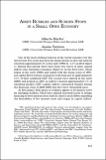Mostrar el registro sencillo del ítem
Asset bubbles and sudden stops in a small open economy
| dc.contributor.author | Martin, Alberto | |
| dc.contributor.author | Ventura, Jaume | |
| dc.date.accessioned | 2019-11-01T00:07:12Z | |
| dc.date.available | 2019-11-01T00:07:12Z | |
| dc.date.issued | 2015 | |
| dc.identifier.isbn | 978-956-7421-47-3 | |
| dc.identifier.uri | https://hdl.handle.net/20.500.12580/3895 | |
| dc.description | One of the most striking features of the world economy over the last twenty-five years has been the sharp decline in the real interest rate from approximately 4% in the early 1990s to -1.5% in 2013 (figure 1). During this period there have been two waves of large capital inflows into emerging economies (figure 2). In the first wave which began in the early 1990s and ended with the Asian crisis of 1997 net capital flows to these economies went from zero to approximately 3.5% of their combined GDP. The second wave started in the early 2000s and peaked in 2007 as inflows reached approximately 5% of emerging-market GDP. Capital inflows contracted sharply during the financial crisis of 2008-2009 but they have rebounded since. | |
| dc.format | ||
| dc.format.extent | Sección o Parte de un Documento | |
| dc.format.medium | p. 315-341 | |
| dc.language.iso | eng | |
| dc.publisher | Banco Central de Chile | |
| dc.relation.ispartof | Series on Central Banking Analysis and Economic Policies no. 20 | |
| dc.rights | Attribution-NonCommercial-NoDerivs 3.0 Chile | * |
| dc.rights.uri | http://creativecommons.org/licenses/by-nc-nd/3.0/cl/ | * |
| dc.subject | TASAS DE INTERÉS | es_ES |
| dc.subject | CRISIS FINANCIERA | es_ES |
| dc.subject | CRISIS ECONÓMICA 2008 | es_ES |
| dc.title | Asset bubbles and sudden stops in a small open economy | |
| dc.type.doc | Artículo | |
| dc.file.name | BCCh-sbc-v20-p315_341 |


